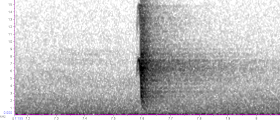The "chimp' call of the Song Sparrow is distinctive among sparrows. Also on this recording made in July at Palmyra Cove, NJ, is a higher chip, which indicates increased agitation, such as when an intruder is close to young or the nest.
.wav.png) chimp
chimp higher chip
higher chipThe call of the Winter Wren can be mistaken for the chimp call of the Song Sparrow, but it is usually given in pairs, but not always as in this recording(Oct,PA).
The sonagrams are very similar.

This recording features three different chip calls, made by two agitated Song Sparrows. In addition to the chimp and high chip calls, there is another call that I believe represents the chet call, apparently only given by females (Aug, PA).

A pair of agitated Song Sparrows, giving a variety of calls, including two different high chip calls, the chimp call, and several different chips (June, NJ).
 two high chips
two high chips chip at 13s
chip at 13s chip at 22s
chip at 22s chip at 2s
chip at 2s chip at 12s
chip at 12sThe Fox Sparrow call is a smacking chip (Mar, NJ).

Note the anomalous chip at 9s:

The call is similar to that of the Brown Thrasher, which is usually louder and more emphatic (Sep, NJ).

The Lincoln's Sparrow chip sounds close to the Fox Sparrow.
Lincoln's Sparrow with fledglings,including two high chips, indicating a high level of agitation(July,CO).
 high chip
high chipThis is a call not often heard in migration in my experience.
Lincoln's Sparrow (Oct, NJ).

The Dark-eyed Junco call sounds like two stones being hit together and is very similar to the chip note of the Black-throated Blue Warbler (White-throated Sparrow and Purple Finch calling, Oct, PA).

Black-throated Blue Warbler (May, PA).

The Savannah Sparrow has a chip that often sounds a little like that of the junco, but appears to be quite variable. Two examples:
(Oct, PA).
(breeding grounds, Jul, ME).

The Swamp Sparrow has an emphatic chip. Eastern Phoebe is similar but lower and more subdued.
Swamp Sparrow (Oct, NJ)
(Oct, PA)
.wav.png)
Eastern Phoebe (Apr, PA).

Swamp Sparrow high chip (Oct, PA).

The Field Sparrow has a somewhat slurred, husky chip (Feb, NJ). The v-shape gives it a slightly doubled, or slurred sound, which is shared by three eastern warblers, Prothonotary, Orange-crowned and Nashville.
(July, NJ)
Note the titter-like calls at 6 and 19s, and the flight call at 41s (Feb, NJ).

 titter
titterProthonotary Warbler chip for comparison (Apr, NJ).
+Parvin+SP,+NJ+42607.wav.png)
The Chipping Sparrow has a high-pitched v-shaped chip (Aug, NJ).
(July, NJ)

This Clay-colored Sparrow chip is even higher (May, ND).

The chip of the American Tree Sparrow does not seem to be heard often in winter. Interestingly, it sounds very similar to the chip of the Hooded Warbler and has a similar sonagram.
American Tree Sparrow (background Carolina Wren, Nov, NJ).

Hooded Warbler (breeding grounds, May, NJ).

The alarm call of the Grasshopper Sparrow, heard here on its breeding grounds, June in NJ, sounds just like...a Grasshopper. The sonagram shows that it is actually a doubled (sometimes tripled) chip. It is also given singly, perhaps when under less stress.
.wav.png)
The commonly given chips of the White-throated Sparrow appear to serve as a contact function as well as an alarm call.
(Nov, PA)
Persistent calls at dawn (Oct, PA)

This bird on breeding grounds occasionally gave a higher chip call, most likely equivalent to the high chip calls given by other sparrows and many warblers when highly agitated (July, ME).

Note how the chip call of the White-crowned Sparrow is shorter than that of the White-throated (leucophrys subspecies,Oct, NJ).

gambelli subspecies (June, AK).

This call has a similar sonagram and can sound similar to the alarm call of the Blue Grosbeak (May, NJ).

The Seaside Sparrow chip sounds very similar to the chip of the Eurasian Wren (Aug, NJ).

The familiar chewink call of the Eastern Towhee (with Northern Mockingbird, Dec, PA).

A variant of the call(Oct, NJ).

Adult pair calling with high chip calls, near fledglings (June, NJ).

No comments:
Post a Comment